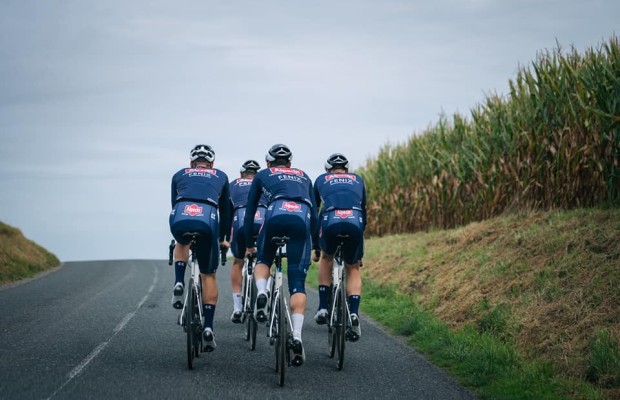From the first detachable tire to tubeless: Michelin, over a century of innovation in cycling
When it comes to tires, few names resonate as strongly as Michelin. The French brand, known worldwide for its unmistakable mascot, its gastronomic guide, and its constant technological advances in the automotive field, has been writing decisive chapters in the history of cycling and competitive cycling for over a century.
Its trajectory, marked by continuous innovation, has found a new reference stage in mountain biking for the past couple of seasons thanks to its role as the main partner of the WHOOP UCI Mountain Bike World Series.
Michelin invented the modern bicycle tire
The history of Michelin begins in 1889 in Clermont-Ferrand, France, with the Michelin brothers, Édouard and André. And although the company gained worldwide notoriety thanks to its car tires, the bicycle played a crucial role in its initial development.

RECOMENDADO

Benefits of training in the cold

The cyclist's patience: how long, gentle training sessions build your best season

Tips for cycling in the rain

25 cycling gifts ideas to get it right

What happens if you skip the diet during the holidays?

When do helmets have to be changed? Do they have an expiration date?
In 1889, the Michelin brothers inherited the small family workshop in Clermont-Ferrand, which had been repairing agricultural tools and bicycle tires. One day, a cyclist arrived with a flat tire and tires glued to the rim (a tubular system like the ones still used in cyclocross), an effective but very difficult to repair system that required hours of work and prolonged drying. Intrigued by the problem, Édouard set out to find a more practical solution. After two years of testing and attempts, the brothers managed to shape the first detachable bicycle tire, which allowed replacing a tire in just fifteen minutes. Thus, the modern tire was born, marking one of the great revolutions in the history of cycling.

The effectiveness of this innovation was soon demonstrated. In 1891, the Frenchman Charles Terront started the legendary Paris-Brest-Paris equipped with the new Michelin tires. He was the only one of the 200 participants to ride with this system and managed to win in an unquestionable way by crossing the finish line with over eight hours ahead of the second-place finisher.
The impact was immediate, and the following year, more than 10,000 cyclists were already using the detachable tires from the young French company. This success marked the beginning of an indissoluble relationship between Michelin and cycling, where innovation has always been the main driving force.
This first great success in cycling served as a springboard to expand horizons. In 1895, Michelin presented the Éclair, the first car conceived by the company and equipped with its own tires, with which it dared to participate in the demanding Paris-Bordeaux-Paris. The experience opened the door to a new testing ground: motor racing competitions. Since then, the French firm has been involved in some of the most prestigious competitions of the time, such as the Gordon Bennett Cup, consolidating an international reputation that would no longer be limited to cycling but would extend to the entire modern mobility sector.
The Michelin Man and the Michelin Guide, two icons of 20th-century culture onwards
In parallel to its technical innovations, Michelin also built a recognizable brand universe worldwide and today is one of the few brands that has transcended the boundaries of its sector to jump directly into popular culture.
At the end of the 19th century, during the Universal and Colonial Exhibition of Lyon in 1894, a stack of tires caught Édouard Michelin's attention. As he observed it, he commented to his brother André that, with arms and legs, it would resemble a doll. That idea took shape a few years later thanks to the illustrator Marius Rossillon, known as O'Galop, who in 1898 created the first sketch of Bibendum, the famous Michelin mascot. Over time, this became a universal advertising icon, chosen even in 2000 as the best logo of the 20th century by an international jury from the Financial Times.

Almost simultaneously, the company launched in 1900 another of its great icons: the Michelin Guide. In a context where there were hardly any cars on the road, the company printed 35,000 copies of its first edition to facilitate road mobility and promote transportation, a practical manual for travelers that included maps, mechanical tips, service stations, and accommodation and dining recommendations. Since then, it has become the global standard for measuring gastronomic excellence, elevating the guide to the rank of a cultural icon and remaining relevant to this day.
Michelin also developed tubeless and continues to lead innovation in cycling
Today, over 130 years after that first detachable tire, Michelin remains committed to cycling. And the brand demonstrates this with new technologies that seek to optimize ground contact, improve safety, and, at the same time, respect sustainability criteria.
This innovative vocation was also evident in 1999 when, together with Mavic and Hutchinson, Michelin introduced the Universal Standard Tubeless (UST), the first tubeless wheel system designed for bicycles. This solution, which revolutionized mountain biking above all, was conceived as an open standard to ensure compatibility between rims and tires from different manufacturers.
Over the years, the tubeless system has spread to virtually all cycling disciplines and has completely transformed the way of riding and competing. If just a decade ago the trend was to use high pressures under the idea that they offered greater speed, today it is proven that the opposite is true. Thanks to tubeless, cyclists can ride with much lower pressures than usual, resulting in a significant increase in traction and comfort, factors that together also lead to greater speed on the ground.

The constant commitment to innovation and the development of cutting-edge compounds have allowed Michelin to remain at the forefront of cycling, with specific solutions for virtually all its disciplines.
In disciplines like E-Bike and Gravity (Enduro and Downhill), Michelin is a very present brand and stands out with specific technologies, such as the E-Bike Ready casing, reinforced to withstand the higher torque of electric motors. Or the patented Cuttable Blocks Technology, a new generation of tread patterns on DH and Enduro tires that allows for quick cuts in the knobs to improve grip and steering precision.
In XCO, Michelin has reference models like the Jet XC2 Racing Line, which incorporates the Cross Shield² casing (with double threads in the bead area to offer maximum resistance without increasing weight) along with the Gum-X compound, capable of balancing fast rolling with effective traction on different terrains. The French brand is also a partner of several teams in the World Cup, and its tires have become common on the podium. An example is Frenchman Mathis Azzaro from Origine Racing Division, who has been seen competing with Michelin catalog models and other easily recognizable Michelin prototypes with the inscription "Work in Progress" on the side. With them, the young rider has already managed to climb the podium on more than one occasion this season.
Together, these technologies allow Michelin to offer a range of tires that can adapt to each discipline and type of cyclist, always guaranteeing safety, performance, and reliability at both the highest competitive level and recreational use.
Michelin in the UCI MTB World Cup
Michelin's presence in high competition is no coincidence. Throughout its history, the brand has understood that sports are the perfect showcase to test its technical advances. In this sense, professional cycling has become a living laboratory, and what works in races eventually reaches amateur cyclists.

This commitment to competition reached a new level in 2024 when Michelin became the main partner of the WHOOP UCI Mountain Bike World Series, the current global reference circuit for XCO/XCC, DH, and Enduro. This agreement not only reinforces the brand's visibility on a global stage but also provides direct support to a sport in full growth, followed by millions of fans and practiced in the most diverse corners of the planet.
Looking ahead, Michelin's relationship with cycling only continues to strengthen. The company continues to invest in new solutions that add value to both professionals and enthusiasts, always maintaining the same principle that guided its founders, innovation in the service of mobility (and competition).